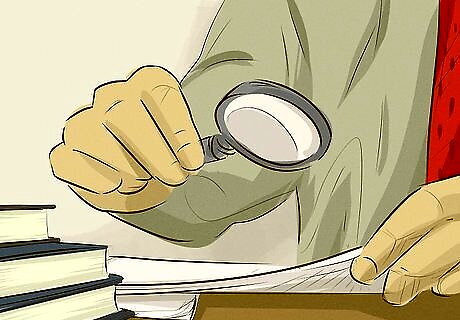
views
Applying for Grants

Obtain an application. Download the application for the grant. Depending on your project, you will need to choose either the multi-project application PDF or the single-project application pdf. Each option includes instructions specific to the government agency administering the grant, along with application forms designed to be filled in offline. Mandatory fields to fill in are highlighted in yellow and include an asterisk. Make sure that your version of Adobe Reader is compatible with the grants.gov web site. If you wish to print out the forms in an application package, you must open each form individually and print it out. There is currently no provision for batch printing the entire package. This may require you to register for an account. You will need to include the Funding Opportunity Number (or FON) of the grant you want to apply for. You can copy the FON number from the description of the grant, which is the upper right hand of the grant synopsis. Highlight the number and then right click on it. Select the "copy" option from the drop down men. Then go to the registration page. Right click again and select the "paste" option. This will put the FON number into the box and hit the "Submit" button. Fill out the registration page according to its instructions. You will then be prompted to create a username and password. Be sure to write these down in a place where you can access them again. Getting an approved, registered account can take 1-3 weeks, so be sure to budget in this time when you are applying for a grant.

Complete the application. The different components of the application will vary with each grant, but you will need to be prepared to write a proposal for your project or research idea. You will need to clearly explain how the funding will help you put your ideas into practice for the particular agency. Complete the SF-424 form first. This form will automatically populate information on other areas of the application, so be sure to finish this first as it will save you time. This a Federal requirement, so it may not be a mandatory requirement for non-Federal applications. Be sure to save frequently. If you are filling out the application on a computer as opposed to manually, you will need to hit the "save" button frequently to preserve your work. Clearly convey your mission. Before you fill out the grant application, you should draft a practice section in which you explain 1) how you will use the grant and 2) how it will benefit the broader community (not just yourself). Write a clear "thesis statement" for your mission. What will this grant help you to achieve? Will you conduct important research with it, will you use it to enrich a local school, community center, or park? Try to write this in a sentence of 50 words of less. Revise and rewrite this sentence again and again until you make it crystal clear. Structure your paragraphs properly. If you are writing multiple paragraphs, then make sure each one starts with a topic sentence that offers a new piece of information. For example, if your first paragraph talks about your interest in education generally, then your second paragraph should discuss your specific plan for using the grant to create an after-school program. Your third paragraph could start with a sentence that discusses the past successes of after school programs in your community (i.e. improved school attendance, better grades for participants, lower levels of bullying, etc.). Include visuals. If you have graphs, charts or other visual metrics that will help convey the necessity of your project, then you should prepare to include these as well. These visuals will give the committee an idea of how you plan to measure your results once you implement the grant.

Submit your application. Check your application again before submitting. Make sure everything is properly formatted, sized, and contains no errors. When submitting, do the following: Keep an eye on the file size. There is a file size limit of 200mb on grants.gov. Individual attachments should also be less than 100mb. Find ways to concisely convey your mission and goals so your application can take up less space. Attachment file names are restricted to 50 characters in length and should not include the special characters &, -, *, /, #, or periods, accent marks or blank spaces. You may separate words in file names with underscores (example: Application_Attachment_File.pdf). To speed application processing, Grants.gov requires that no two files in an application package have the same name. If you have working files with the same name, you'll need to rename them before attaching them to your application. Video (.mpeg, .mov, .avi), graphic image (.gif, .jpg, .tif) and audio (.aif, .au, .wav) files should be compressed before being attached, according to the standards of the government agency administering the grant you're applying for. Check for errors. Your application must be error free before you can successfully submit it. Click the "Check Package for Errors" button on the application to make sure your application is correct. Obsessively proofread. Your grant will be quickly dismissed if it includes any errors such as typos, grammatical errors or other technical problems. Show the committee you pay attention to detail and thoroughly edit your application. Save and submit. The final step in the application process entails hitting the Save & Submit button. This will become available once all of the errors are corrected.

Follow up on your submission. During the next 2 business days after your submission, Grants.gov will notify you twice by e-mail, first to notify you they have received it and then to notify you that it has either been validated or rejected for technical errors. Keep your tracking number. Once you have successfully submitted your grant, you will be sent to a confirmation page on-line. The confirmation page will give you a tracking number that you can use to look up the status of your application. If your application been validated, you will receive a third e-mail from Grants.gov notifying you that the agency administering the grant has received your application, which may followed by another e-mail to notify you that the grantor agency has assigned its own tracking number to your application. Before the grantor agency replies, you can follow up with Grants.gov by clicking "Track My Application" on the website's left navigation bar. Enter the tracking numbers for the applications you want to check on; you can enter up to five. To check on a larger number than this, log in to Grants.gov and use the Check Application Status link.

Review reasons for rejections. Grants.gov awards most of its grants to organizations; as an individual applicant, you may find the odds are stack against you. Your application may be rejected because it did not fulfill the technical requirements for submission. But it is more likely that you simply cannot complete the large task of the grant simply on your own. Many federal grants are awarded to fund projects that can become models for future research initiatives in government agencies. As a single applicant, your project might be too specialized or limited to become a representative model. You may be able to successfully reapply for the grant by adjusting content or making the changes necessary to correct deficiencies in a rejected application.
Understanding the Grant Process

Assess your skills and needs for a grant. Grants provide you with the backing, financial or otherwise, to do something that you could not do otherwise. Grants can allow scientists to perform research, give charities the money to help others, and allow students to pursue higher education, among other things. You should apply for a grant when your current resources do not allow you to do something constructive that you desire to do. When deciding to apply for a grant, remember that locating, applying for, and winning a grant will be time-consuming and somewhat difficult. Ask yourself if you can realistically complete your goals without the grant money before applying. Consider the pros and cons of other sources of funding.

Identify potential sources of grants. Grants can be obtained from a wide variety of sources, from federal, state and local governments to many types of organizations and institutions. Your goal should be to find an organization or government that promotes the activity or purpose you need the grant for. Common sources for grant include the following: Visit Grants.gov. This government site contains easily-searchable listings for a multitude of federal grants. Look for scholarships with the Department of Labor. If you are looking for money to fund your tuition, then the DOL has a broad listing of scholarships that are available and it is free to use. Apply for individual fellowships and grants with specific agencies. Many agencies have fellowships that are available to applicants whose research interests match their general mission. For instance, if you are a writer, you might consider applying for an individual fellowship or research assistantship with the National Endowment for the Arts. Look beyond government sources of funding. If you need a grant to fund a personal need, such as tuition, a home repair, or starting a business, then look to non-profit organizations and charitable organizations in your local area. You are more likely to receive funding from a local source than a national one.

Understand eligibility for grants. Grants always come with conditions, whether for the applicant or the project in question or both. For example, you may have to be a student of a certain age to apply for one grant, but a research team with certain qualification to apply for another. Grants may be set up such that they can only be used for certain purposes as well. If you do not meet the qualifications, or are unable to convince the grant committee that you do, you will not be able to get the grant. Be sure to carefully research grant requirements and restrictions before applying.
Finding Grants that Fit Your Skills and Needs

Search for eligible grants. There are thousands of federal, state, educational, charitable, and corporate grants available to search for online, but most of them are designed for organizations and governmental agencies. You should not waste time applying for these as an individual because you will be quickly deemed ineligible. When you go onto the grants.gov web site, be sure to first check the box labeled "Individuals" under the Eligibility section. This will filter out the results so you only see grants you are eligible to win. If you are looking for funding for your personal education, the department of labor will be a more successful route than grants.gov. Considering looking for a Pell Grant by filling out a copy of the Federal Application for Student Financial Aid. You can find a nation-wide listing of non-profits at the National Directory of Non-Profit Organizations. Research organizations that are designed to help your needs (i.e. don't apply for a grant that supports medical operations when you need tuition assistance). Most local governments also maintain a list of non-profits in their districts. Google the name of your county or city and then the word "non-profit" to find a list. Avoid applying for money at local foundations. Foundations generally award money to non-profits, who in turn use money to support individual applicants.

Understand individual grant requirements. Many federal grants for individuals are specific in scope. They may be designed to help an individual conduct research or help complete a project at a federal institution (like the Department of Energy). They are also often designed to help strengthen relationships between the federal government and an international population living in the United States. If you are looking for a grant to help pay off personal debt -- as in a credit card or student loan debt -- it is unlikely you will find this through the federal government.

Make a list of eligible grants. Because the grants are often very specific in nature, it is unlikely you will be a good fit for more than one. But you should still keep a list of the grants you plan to apply to so you can stay organized during the application process. You should keep this list in an accessible place, like a notebook that you use frequently or save this list on your computer. Consider backing up your documents in cloud space like Dropbox or Google Cloud.

Prioritize grants by needs and skills. Grants should be applied for in the order in which they are likely to be successful. Ask yourself if a specific grant fits your needs and skills. What is the likelihood of success? Prioritize those grants that you think you have the highest chance of getting and apply to these first.



















Comments
0 comment